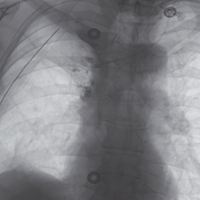Lipiodol lymphangiography as a treatment for refractory postoperative chylothorax: a case report

Submitted: November 11, 2020
Accepted: April 28, 2021
Published: June 7, 2021
Accepted: April 28, 2021
Abstract Views: 1043
PDF: 472
Publisher's note
All claims expressed in this article are solely those of the authors and do not necessarily represent those of their affiliated organizations, or those of the publisher, the editors and the reviewers. Any product that may be evaluated in this article or claim that may be made by its manufacturer is not guaranteed or endorsed by the publisher.
All claims expressed in this article are solely those of the authors and do not necessarily represent those of their affiliated organizations, or those of the publisher, the editors and the reviewers. Any product that may be evaluated in this article or claim that may be made by its manufacturer is not guaranteed or endorsed by the publisher.
Similar Articles
- H. Halilcolar, S. Yapicioglu, S. Bilaceroglu, Temporal Changes in Lung Cancer: A 10-year Study in a Chest Hospital , Monaldi Archives for Chest Disease: Vol. 69 No. 4 (2008): Pulmonary series
- Piergiorgio Muriana, Angelo Carretta, Paola Ciriaco, Francesca Rossetti, Giampiero Negri, Isolated tension pneumoperitoneum following endobronchial ultrasound-guided transbronchial needle aspiration complicated by cardiac peri-arrest: A case report , Monaldi Archives for Chest Disease: Vol. 88 No. 3 (2018)
- Davide Zampieri, Alessandro Pangoni, Giuseppe Marulli, Federico Rea, Acquired tracheoesophageal fistula repair, due to prolonged mechanical ventilation, in patient with double incomplete aortic arch , Monaldi Archives for Chest Disease: Vol. 88 No. 3 (2018)
- G. Leoncini, L. Iurilli, L. Boni, G. Blanco, P. De Bellis, G. Catrambone, Treatment of iatrogenic and traumatic tracheal disruptions , Monaldi Archives for Chest Disease: Vol. 69 No. 3 (2008): Pulmonary series
- Sotirios D. Moraitis, Apostolos C. Agrafiotis, Amalia Kapranou, Marina Constantinou, Konstantinos Kanakakis, Panagiotis Hountis, Occurrence of thymic pathology in two families. Is familial screening justified? , Monaldi Archives for Chest Disease: Vol. 88 No. 3 (2018)
- B. Uskul, H. Turker, C. Ulman, M. Ertugrul, A. Selvi, A. Kant, S. Arslan, M. Ozgel, The relation of the pleural thickening in tuberculosis pleurisy with the activity of adenosine deaminase , Monaldi Archives for Chest Disease: Vol. 63 No. 2 (2005): Pulmonary series
- K. Pawelczyk, M. Marciniak, G. Kacprzak, J. Kolodziej, Surgical treatment of lung cancer in patients under 45 years of age , Monaldi Archives for Chest Disease: Vol. 65 No. 4 (2006): Pulmonary series
- P.E. Van Schil, J.M. Hendriks, M.G. De Maeseneer, P.R. Lauwers, Current management of spontaneous pneumothorax , Monaldi Archives for Chest Disease: Vol. 63 No. 4 (2005): Pulmonary series
- Sotirios Moraitis, Dimitrios Moraitis, Maria Chounti, Panagiotis Hountis, Aneurysmal rib cyst , Monaldi Archives for Chest Disease: Vol. 87 No. 3 (2017)
- K.M. Antoniou, N. Tzanakis, K. Malagari, K.E. Symvoulakis, K. Perisinakis, N. Karkavitsas, N.M. Siafakas, D.E. Bouros, Clearance of technetium-99m-DTPA in pulmonary sarcoidosis , Monaldi Archives for Chest Disease: Vol. 65 No. 3 (2006): Pulmonary series
You may also start an advanced similarity search for this article.

 https://doi.org/10.4081/monaldi.2021.1676
https://doi.org/10.4081/monaldi.2021.1676





